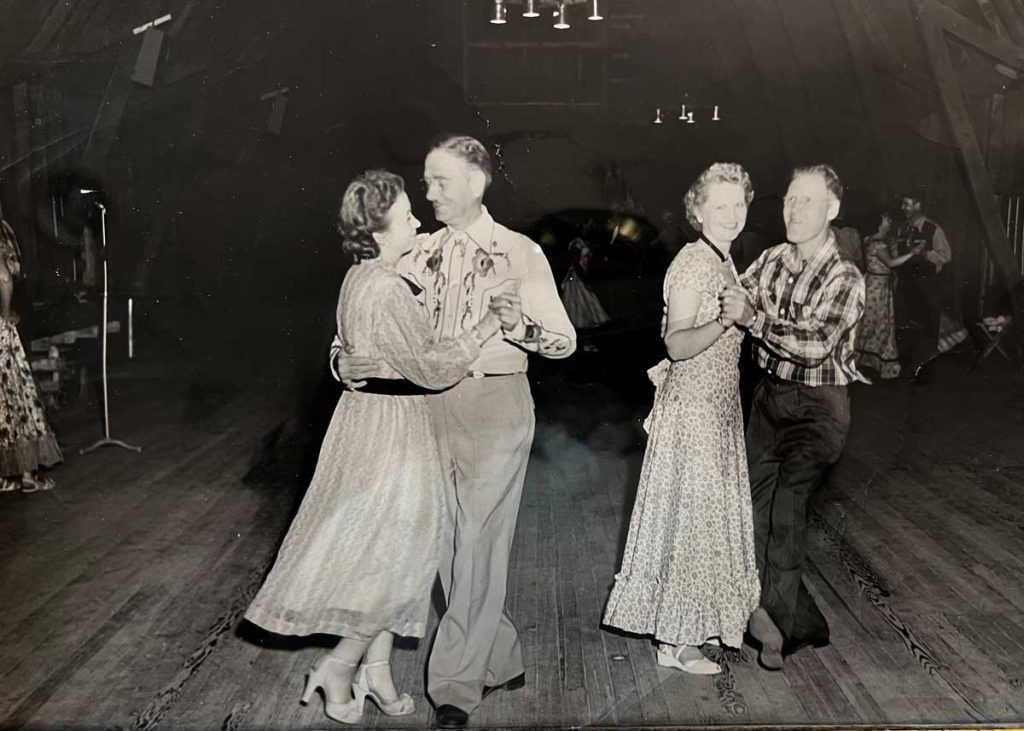Welcome back to our second and concluding article regarding the history of square dancing in Park City.
In 1949 Judd and Beth Flinders purchased a 900-acre dairy farm in Kimball Junction. During the depths of the Depression, they opened three restaurants in Salt Lake City. Under their customer first philosophy, all three businesses flourished. Besides the eateries, the family operated a small yet diverse farm in Millcreek. It too was a money maker. The demands of their success encouraged the family to buy the Park City ranch. On their new property, the Flinders would continue their winning ways for decades to come: Over time the family developed nine separate yet interrelated businesses on their property. One of them was square dancing.
In 1950 Judd applied for a license to operate a dance hall and confectionery business in Kimball Junction. This coincided with the opening of the Flinders Mountain Meadow Ranch Restaurant. In no time it became one of finest family style restaurants in the area. After operating the dairy farm for several years, Judd determined that raising beef cattle was financially superior. He made the transition without hesitation.
An added benefit of the change: the elimination of milking operations on the lower level of the Big Red Barn. Of course, the massive hayloft remained a necessity to store cattle feed for winter’s duration. However, the hayloft was empty by the middle of May and would remain so until the end of August. Thus, the hay loft could be leveraged to start a new seasonal business. Square dancing beckoned.
Before the move to Park City, the Flinders were well versed in the nuances of square dancing. A family friend, Wilf Marwadell, was a PE instructor at the University of Utah (the U). The U offered a course in square dancing for one credit. Wilf was both the instructor and caller. He also belonged to the same LDS ward as some of the Flinders relatives in Salt Lake City.
Predictably, square dancing events occurred regularly at the church. On such occasions the dance floor was jammed with adults and children enjoying themselves. A bigger venue was needed. Judd had a solution: modify his hayloft to accommodate dancing. He wasted no time doing so.

Credit: Courtesy of the Flinders Family.
Judd installed a set of ten-feet-wide stairs to access the loft. Next a sound system, a calling stage, lighting (wagon wheels with tin cans as shades) and an ample supply of ‘78 RPM records. The entry fee was $1.00. Ice cold soft drinks were ten cents. The loft could hold 194 dancers, or 24 squares. The first event sold out, and it would not be the last.
During the summer season, dancing occurred Friday and Saturday nights. Another of Judd’s many talents included promotion. He commissioned the painting of a billboard on the front of the barn, which faced Old Highway 40, advertising square dancing. The Flinders barn became a mecca for dancing and fun. Alas, the advent of haying season signaled the end of square dancing (in the barn) until the next May. The Flinders hosted the seasonal dances for over 25 years.
We’ll close out this story with a patter familiar to those aficionados of square dancing … “All jump up and never come down, swing your honey round and round, ‘til the balls of your feet make a hole in the ground. Granny, does your dog bite? No child, no.”
The author thanks the surviving Flinders siblings (Leland, Melvin, Jerran and Elizabeth) and Scott Smith for sharing their memories of square dancing at their Big Red Barn.
The next FREE ADMISSION day at the Park City Museum is Saturday, August 17. Free Days are sponsored by the Summit County Restaurant Tax Grant Program!